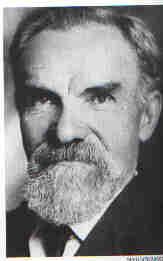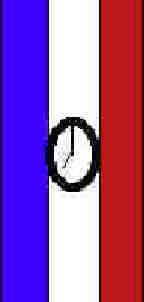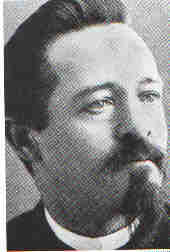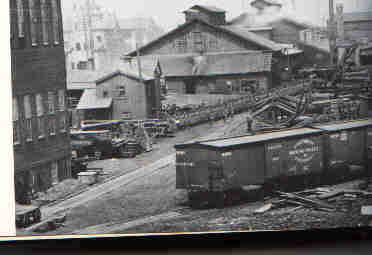The Rolling Mills
Also Known as the Massacre at Bay View
May 5th, 1886
A Historical marker is located at Russel and Superior on Jones Island in Bay View. It commemorates the Bay View Massacre.
Overview:
Milwaukee Iron Company rolling mill (also known as the Bay View Rolling Mill, North Chicago Rolling Mill, and United States Steel) located in Bay View operated the first major heavy industry in the region, iron and steel production. The rolling mill which opened in 1868, was first built to re-roll railroad rails, but then started to manufacture new rails transforming ore from Dodge County and Lake Superior area mines. In 1883 the furnaces were operated by the North Chicago Rollowing Mills. By 1885, more than 1500 people were employed at the plant, some recruited from the iron-producing districts of the British Isles. The village of Bay View grew from a rural crossroads into an industrial community surrounding the rolling mill.
In early labor history there was no one looking out for the workers and as a result employers were working them ten hours a day, six days a week for ninety cents to one dollar and fifteen cents a day. In Milwaukee, groups, such as the Central Labor Union led by a Socialist Paul Grottkau and Catholic Church's Knights of Labor led by Robert Shilling, were formed to work for workers rights. One thing these groups were asking for was an eight hour workday with no reduction in pay. The Federation of Organized Trades and Labor Unions called for a great movement to win the 8-hour workday, which would climax on May 1st, 1886. Their plan was to spend two years urging all American employers to adopt a standard eight hour day, instead of the 10 to 12, even up to 16-hour days that were prevalent. After May 1st of 1886, all workers not yet on the 8-hour system were to cease work in a nationwide strike until their employer met the demand. In Milwaukee they formed the eight hour league with the purpose of persuading the local government to adopt the eight hour workday. Milwaukee adopted it but the law had no penalty for employers whom did not comply. These groups were extremely upset with what was happening and planned a series of demonstrations on May 1st 1886, when the law was to take effect. There were over 1600 such demonstrations across the country. These demonstrations led to serious trouble in Chicago's Haymarket Square, where on May 3rd Chicago police shot four workers to death and on May 4th someone unknown hurled a bomb into the police ranks killing several officers and wounding many more and there was more trouble at Rolling Mills in Milwaukee as a somewhat peaceful demonstration turned ugly. The following events led up to what is known today as the Massacre at Bay View.

Robert Shilling editor of the Volksblatt or Peoples Place

The Eight Hour Flag One similar to this was carried at the Rolling Mills. According to the Milwaukee Sentinel the man who carried it was shot through his jaw and had to live the rest of his life with a silver jaw.
May 2nd
The central labor union held a parade in Milwaukee. They marched with banners proclaiming slogans such as "The workmen do not beg, they demand", "We do not work for King Mammon" and "Eight hours is our battlecry". The Milwaukee Journal billed it as the biggest event in city history. Wisconsin Governor Jeremiah Rusk was concerned about violence as strikes for the eight hour day were happening in the city. On April 29th, he had put the state militia on standby.
The parade was watched by some 25,000 people and afterwards there was a picnic at the Milwaukee gardens with speakers denouncing the ten hour workday and voicing concerns over employers taking advantage of employees. They worked the crowd into a frenzy and before long everyone was chanting eight hours.
Some members of the Knights of Labor were in attendance, Afterwards they went back to their headquarters at St. Stanislaus Church [Fifth and Mitchell] and spoke to some of their members. Soon afterwards eight hundred started marching through the streets of Milwaukee chanting eight hours everyone must strike. Polish workers and tradesmen stopped their work and joined the march.
The first factory they came to was CM&STO Car Company who built railroad cars. After gaining recruits there they marched to Edward P. Allis Reliant Steel works. There the marchers were met by foreman and supervisors who tried to keep the marchers away with high pressure water hoses, but when the workers inside heard the chanting they stopped working and joined the march. The marchers continued and got more recruits as they went along. Businesses were closing at an alarming rate due to labor shortages.
The owners of CM&STO Car Company put a special train at Governor Jeremiah Rusks disposal. He rushed to Milwaukee and set up his office at the Plankinton Hotel where employers were asking Governor Rusk to call out the militia. Rusk at this point saw no reason as he did not want to overstep the city.
The workers continued their strike and got more recruits. The Milwaukee police trailed the crowd hoping there would be no violence.
Governor Rusk was asked again by employers to call out the militia and again he said no.
May 3rd
The strikers have shut down every factory in Milwaukee except one, The North Chicago Railroad Rolling Mills Steel Foundry in Bay View. The chant now goes out eight hours, everyone must strike, onto the mills. By this time the marchers were now numbering about fifteen hundred. The marchers consisted of mainly Polish, some Germans and some Native Americans. Meanwhile, the number of strikers in the city numbered about twelve thousand.
Robert Shilling convinced Edward P. Allis to offer it's workers the eight hour day with a pay increase. However, the workers were too caught up in the moment and refused to come back unless everyone got an eight hour day. Both Shilling and Grottkau tried to talk the crowd into dispersing speaking their native language, but the workers paid no heed. The English speaking reporters did not understand the languages and reported that they were inticing the crowd.

Paul Grottkau editor of the Arbeiten Zietung or Voice of the Worker
The town police followed the crowd into the Bay View Neighborhood late in the afternoon and called Governor Rusk to inform him that they did not have adequate forces if violence should occur. Rusk now called out the Militia, including the Kosciuko Militia made up mainly by Polish businessmen.
The strikers began negotiating with the supervisors at Rolling Mills for permission to enter the plant and talk to the workers. The plant manager refused and the crowd would not let him back inside until he accepted. The Lincoln Guard arrived on the scene by special train and immediately helped him get back in. Then they formed a line between the strikers (who are now throwing rocks) and the mills. Their orders were to protect the property at all costs. Inside the Mills workers were arguing with each other over the eight hour work day.
By nightfall there were over two hundred and fifty National Guardsmen at the mills, but the closest unit, The Kosciusko Guard, has not arrived yet.
May 4th Early in the morning the Kosciuko Guard arrived on foot, to jeers and name calling as strikers called them traitors to their fellow countrymen. while others were saying join us or go home. The strikers then formed a wave of people between the Kosciuko Guard and the Mills to stop them from joining the Lincoln Guard. There was not one person in the Kosciuko Guard who did not recognize someone striking. Some strikers were throwing rocks at the Kosciuko Guard, several members in the rear of the guard got scared and fired in the air over the heads of the strikers and accidently hit the Mills. After this incident, the strikers left the Guard alone and they proceeded into the Mills joining the other units called.
The strikers then asked the supervisors to wire their headquarters in Chicago to start negotiations on an eight hour work day. They agreed but the answer from Chicago was fast and short "No". At this point no one in the crowd knew about the ugly events unfolding at Haymarket Square, where a bomb killed four police officers and wounded many more
Governor Rusk was under considerable pressure from employers to stop the strike. Employers were saying that they would turn the entire society upside down and use the bombing in Haymarket Square as their proof that a revolution is under way. Rusk called the Mills and told Captain Treaumer of the Lincoln Guard "if the strikers try to enter the mill, shoot to kill."
Captain Treaumer then ordered his men to pick out a man, concentrate and kill him when the order is given. The strikers spent the night in open fields nearby while the Militia camps stayed at the Mills with sentries posted. During the night the sentries were shooting at anything that moved. A Navy tug brought provisions for the guard.
May 5th Around nine in the morning the strikers gathered again chanting eight hours, a reporter who slept with them reported that it was odd that this was a group with no real leadership, but everyone was united in one single purpose. The crowd approached the mill and faced the militia who were ready to fire. Before Treaumer knew the crowds real intentions he ordered halt, but the strikers, who were about two hundred yards away, did not hear him. He ordered fire and seven people lay dead and others were injured. The crowd was in chaos as people were running from the scene. The Milwaukee Journal reported that six were dead and at least eight more were expected to die within twenty four hours. Meanwhile, some strikers were calling for revenge on the militia but to no avail. For several days afterwards a few strikers were still marching throughout the city but no one would join them.
The dead included a thirteen year old boy who tagged along with the crowd wondering what was going on and a retired worker who lived in Bay View. He was struck down by a stray bullet, as he was getting water and was not part of the strike.
The Dead: Frank Kunkel Frank Nowarczyk John Marsh Robert Erdman Johann Zazka Martin Jankowiak Michael Ruchalski
May 6th Leaders of labor groups met with Governor Rusk and asked him to pull back the Militia. They stated they would police their own actions, but Rusk refused until the strikers disbanded and went back to work.

Wisconsin National Guardsmen at the E.P. Allis Steel Works during the strikes
Aftermath
While cleaning up the guardsmen found two more bodies along the railroad tracks. They were apparently Polish immigrants who were on strike. The two remain unidentified to this day.
Everyone went back to work at ten hours a day.
On May 9th, The Milwaukee Journal reported that Edward P. Allis was firing it's Polish workers and replacing them with other nationalities because the Polish people were too radical. Other companies follow suit for the same reason and for a time no Pole could find work in Milwaukee. Meanwhile the Polish section boycotted the businesses of the Kosciuko Guard members.
The National Guard pulled out on May 13th.
An inquiry of the events praised the guards actions calling it an unpleasant duty, a humane gesture for firing only one volley and indicts at least twenty Poles for leading an unlawful assembly. They were sentenced to hard labor ranging from six to nine months. Among these were Paul Grottkau who received the stiffest sentence of nine months. Robert Shilling was also indicted but his first trial ended up in a hung jury. While waiting for a second trial he formed the populace party, who elected a new district attorney. He was formally acquitted.
The Milwaukee Journal reported that businesses were giving cash to the Militia units for their actions at Rolling Mills. The Journal denounced the action saying they did what was expected of them and this was going to far.
As a result of public sympathy for what had happened, the voters of Milwaukee county replaced the county and city governments with socialist representatives in 1888. Since then Milwaukee has had at least three socialist mayors the last one serving from 1948-1960. Mayor Hoan served 24 years. Victor Berger served in congress for 29 years. In 1916, he was banned from his seat for his stand on U.S. involvement in World War I. He felt it was a Capitalist war to make money for big business. During his ban, he was re-elected. His Newspaper "The Leader" was called disloyal and the U.S. Postal Service was prohibited by the disloyalty laws to deliver it thru their system.
The eight hour movement was derailed and political parties were formed to fight for the rights of workers, the eight hour workday and child labor laws. Among these are the Socialist Labor party, the Populace Party (led by Robert Shilling), and the Progressive Party founded by fighting Bob LaFollette who became Governor of Wisconsin. He then went on to Congress where he died still in office, in 1924 after a close bid for president. His son took over his office and held it until 1948 when the Progressive Party folded.
The Knights of Labor are no longer recognized by the Catholic Church to preserve the Church's image. They joined with other Unions to form the American Federation of Labor. The Central Labor Union also joined with other unions and call themselves the Congress of Industrial Organization. Several years later the two major Unions merge calling themselves the AFL-CIO.
Sources: The History of Bay View, Bernhard C. Korn, 1948
The Wisconsin Historical Labor Society
The Milwaukee Historical Preservation Society
The History of Wisconsin, Paul Nesbit
Every year the Wisconsin Labor Historical Society holds a memorial service for those that died at Rolling Mills. After the small service they lay wreaths in the approximate vicinity of where the incident happened.
The service is usually held on the first Sunday in May.
Contents of this page ęcopyright 1998, David Semenske
The Historical accuracy of this page cannot be guaranteed one hundred percent. It is a compilation of works on the subject by local authors.
News Articles
The Daily Northwestern (Oshkosh, Wisconsin) 1886 May 4
The Militia Out
Fighting Going on in Milwaukee Today
News from Bay View that the Iron Works are being beneiged and that Fighting has Occurred
-The First Regiment Called Out and Proceeding to The Scene-The Local Militia Stoned by the Mob and Several Injured-One Volley Fired by the soldiers-The Railway Officials Call for Protection-Streets Filled with Excited People-Fears of Great Trouble and Bloodshed To-Night.
Milwaukee, Wis. May 4-A report from Bay View is that a mob has assembled at that place and is about to assault the works. Fighting has occurred. No details have been received. The light horse squadron is now assembling at the armory to proceed to the scene.
Milwaukee, Wis. May 4, 11 a.m.-Reports from the southern limits of the city show that several crowds of idle men, numbering into the hundreds, have assembled at various points. It is believed that rioting will be avoided. Several manufacturing establishments have been visited by the committee of strikers and ordered to close down. A number of the proprietors have complied. Different companies of the Fourth Battalion are now assembled at their various armories, ready to move at a moment's notice. Governor Rusk has also ordered the Governor's Guards, Madison and Watertown Guards to the city and they are now on their way by special train. With these companies added to the local militia force upon the field it is believed the crowds of idle men will think better of their inclination to indulge in riotous proceedings and quiet will soon be restored and preserved.
11:30 A.M.-Reports from Bay View announce the gathering of idle workingmen to the number of seven or eight thousand. Two militia companies have been sent to Bay View by train and the Light House Squadron will depart in a few minutes.
Milwaukee, May 4-Noon-Upon the request of Mayor Wallber the governor has issued an order to the following companies of the First regiment to appear at Milwaukee at the earliest possible moment: Janesville (two), Racine(two), Monroe, Beloit, Delavan, Whitewater, Darlington, Co. "I" of Madison. A message just received by Governor Rusk from Bay view says the strikers are increasing in numbers and have swarmed into the rolling mills. The Koskiusko guards have been ordered out.
Milwaukee, Wis, May 4-Tremendous excitement has existed throughout the city today. As early as nine o'clock word came from Bay View that a mob was attacking the iron works there, that the laborers about the institution had joined the strikers and that an assault was being made on the iron workers, and that the works were threatened with destruction. The company appealed to the governor for aid and the Fourth Battalion consisting of the Sheridan Guards, Kosciusku Guards, South Side Riles,, and Lincoln Guards were summoned and dispatched to the scene as promptly as possible. The mob was found to consist of several thousand infuriated men who defied all powers of the civil authorities and were hooting and yelling at the iron workers within, who were barricaded and prepared to defend themselves with their lives if necessary. The militia on their arrival served to hold the mob in check for a time, but the more bold element in the crowd even defied balls and bayonets, and daring the militia to fire, made a rush towards the works. The militia, upon orders, fired one volley, aiming high, so as not to injure any one, and this had the effect to dampen the ardor of the crowd for some time. In the meantime thousands from all parts of the city hastened to Bay View to join the rioters until the crowd that assembled near the works was swelled to frighten proportions, yelling shouting, jeering and using insulting epithets towards the militia. The riotous spirit seemed to spread so like wild fire throughout the city and also in view of the fact that the St. Paul and other railroad companies had asked for state protection, the governor telegraphed for the companies of the First Regiment, which are now on the way to Milwaukee on special trains. The streets down town are crowded with people discussing the riot and the probabilities of it spreading to other manufacturing institutions and elsewhere in the city. Everybody is excited discussing the situation, and the newspaper offices are besieged for news. The latest news from Bay View is that the mob is hourly becoming more demonstrative and that a collision between the rioters and militia is iminent [sic] and may be expected at any moment. That there will be bloodshed before night is anticipated by everybody. Howling bands of strikers go through the streets with defiant air, which gives anticipation of new outbreaks and still worse troubles tonight. the Light Horse squadron was not sent to Bay View but held under arms at their armory in case of an emergency in the city. Militia from Madison and Janesville are on the way at 50 miles an hour and when they arrive will be sent to Bay View and other companies will be detailed about railroad property or elsewhere where danger may be threatened.
four companies of militia are stationed at Bay View. Upon the appearance of the soldiers they were stoned y the mob and several men were slightly injured. Captain Borchardt of the Kosciusko guards was struck with a brick. He ordered the men to fire one round into the air. The Bay View rolling mills are closed. General manager Miller of St. Paul road asks the Sheriff for protection for the company's freight houses which are threatened.
The Daily Northwestern (Oshkosh, Wisconsin) > 1886 > May > 5
BLOODSHED.
Several Men Killed in Milwaukee
Collison Between the Militia and Rioters in Bay View-five Men Reported Killed and Ten Wounded-Attack on the Allis Works and the Best Brewery-More State Militia Ordered Out.
Milwaukee, Wis., May 5, 10 a.m. News from Bay View is just received to the effect that a collision has occurred between the strikers and militiamen and that five men have been killed and ten seriously wounded No particulars are yet received.
Reno Evening Gazette (Reno, Nevada) 1886 June 24
An Anarchist Convicted.
Milwaukee, Wis., June 24. The jury, in the cases of John Protzmann and Herman Lampel, this morning brought in a verdict of guilty as to the former and not guilty as to the latter. it was shown that Protzmann took a leading part in the riot at Brand's stove works and the Bay View Rolling Mills. The case of Henry Dampf is now occupying the attention of the court.
Other source: History of the manufacture of iron in all ages By James Moore Swank
Copyright © 2017 - All Rights Reserved - Links To The Past Genealogy
Template by OS Templates